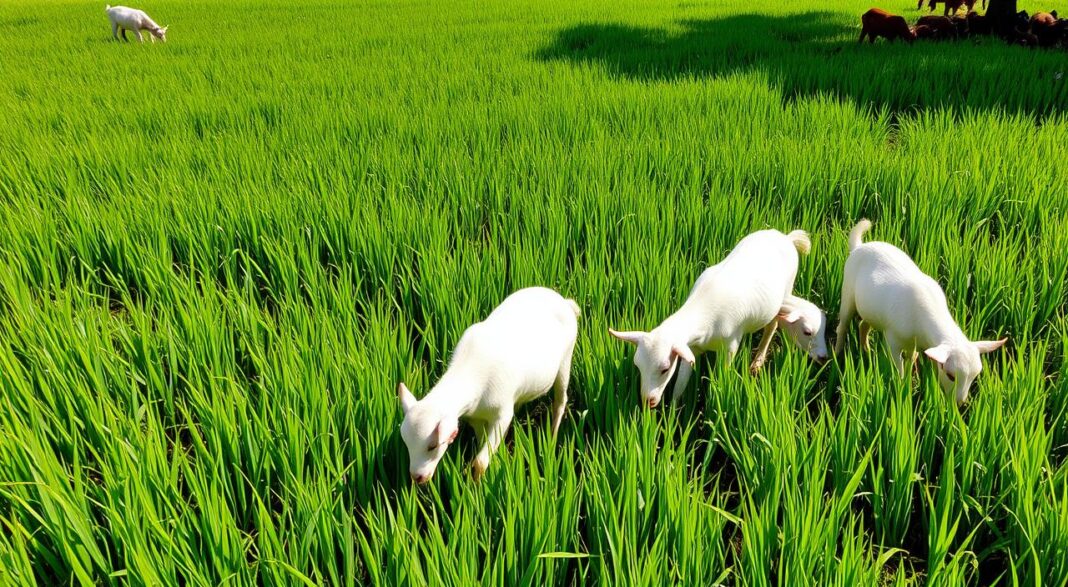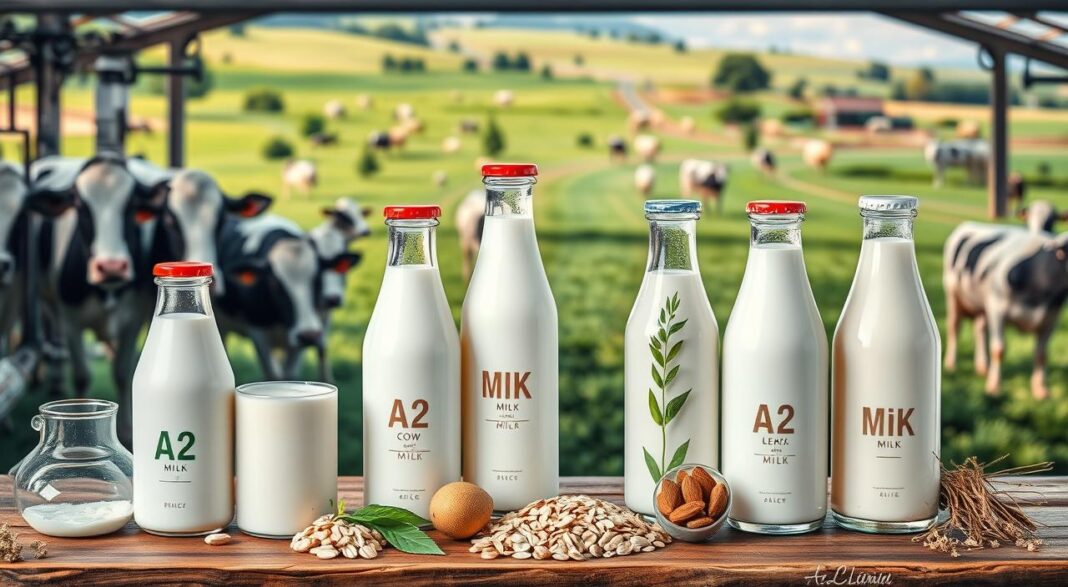Mombasa Grass for Goats Benefits
Goat farming plays a big role in agriculture, giving meat, milk, and jobs worldwide. One key factor for success in goat farming is the food quality for goats. Mombasa grass, known scientifically as Panicum maximum, is a top feed choice. It provides a lot of nutritional benefits for goats. This grass can yield between 10 to 15 MT/acre of dry matter annually. So, it has changed how farmers feed their goats for the better.
The reason Mombasa grass is exceptional for goats is its high productivity and adaptability. It thrives in hot climates, where daytime temperatures go above 30°C and night temperatures stay over 22°C. This grass grows well in many places, from Vietnam to Spain. Coming from Tanzania and brought to Brazil in 1993, it’s now key in goat diets in many countries, improving goat health benefits from Mombasa grass.
For best results, plant the grass on ridges as recommended. With good fertilization, it keeps its high crude protein, vital for goats. When it’s 6 feet tall, it’s ready to be cut and fed to the goats. This feeding boosts their health and productivity. To see more benefits, check out examples and case studies here. It’s also very good for rainy seasons because it handles humidity well.
Key Points
- Mombasa grass yields a massive 10-15 MT/acre of dry matter annually, a substantial contributor to forage availability.
- High digestibility and palatability make Mombasa grass a preferred choice among different livestock, particularly goats.
- High in crude protein and other nutrients, Mombasa grass supports the immune function and boosts the performance of goats.
- Adaptable across many climates, this grass thrives in high temperatures and humidity, making it a reliable year-round feed source.
- Mombasa grass is cultivated globally, with seeds exhibiting a purity of over 99%, reflecting its quality and care in production.
- Appropriate planting and maintenance practices, including the use of fertilizers, enhance the grass’s nutritional content for goats.
Understanding Mombasa Grass and Its Place in Goat Nutrition
When you start goat farming, it’s key to know about nutritional role of Mombasa grass. This forage is vital for livestock’s diet and health. Mombasa grass is rich in nutrients and comes from a unique area, making it a top choice for goats.
Origins and Characteristics of Mombasa Grass
Mombasa grass comes from Tanzania in Africa. It grows well in tropical and subtropical climates around the world. This grass adapts to various soils and is great for feeding livestock.
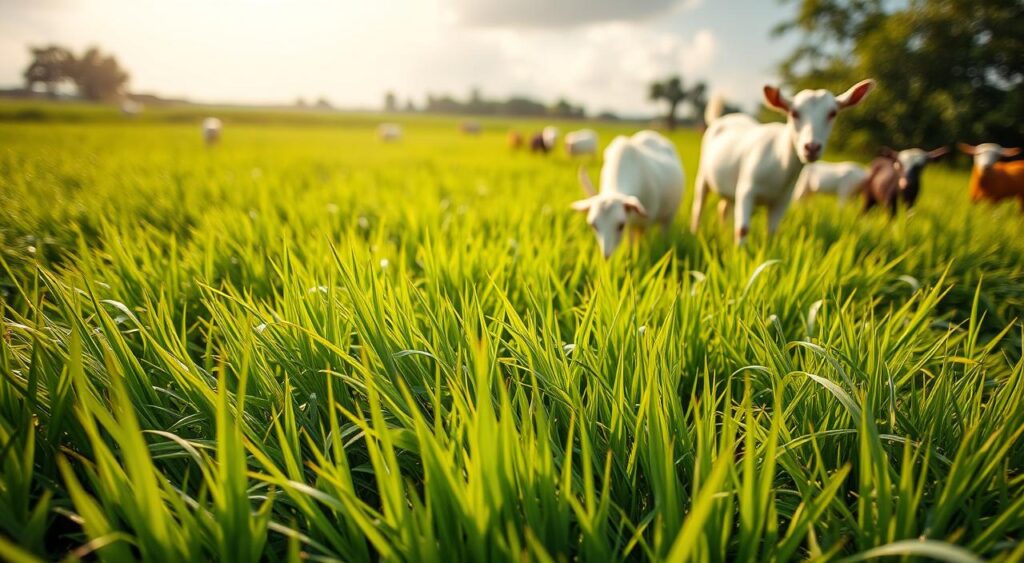
Mombasa grass is full of protein and important nutrients. It also fights off pests like Deois sp. and Mahanarva fimbriolata. This makes it a dependable food source all year round.
Why Goats Thrive on Mombasa Grass
Goats do well on Mombasa grass because it’s full of good stuff like vitamins and minerals. These nutrients boost goat health and productivity. Mixing Mombasa grass with other forages balances the diet, which helps goats grow better.
The benefits of Mombasa grass for livestock are clear because goats love to eat it. For more about goat nutrition, check these expert discussions. They explain why Mombasa grass is important for a goat’s diet.
Using Mombasa grass can improve your goats’ diet and also help your farm be more eco-friendly. It’s a smart choice for both experienced and new goat farmers. It boosts your livestock’s health and helps your farm do better.
Nutritional Profile of Mombasa Grass for Goats
Mombasa grass is not just basic feed for goats. It greatly boosts their health and productivity. Goats show noticeable improvement when this grass is part of their diet. It’s all thanks to its rich nutrients.

This grass has a lot of crude protein, vitamins, and minerals. These are key for goats’ health and function. Let’s look closer at why Mombasa grass is so crucial.
Crucial Vitamins and Minerals Present in Mombasa Grass
Mombasa grass is full of vitamins and minerals necessary for goats’ growth and immune health. It has a high protein level (11.65%) and important amino acids. These help with muscle build and healing. Its protein level is high compared to other goat feeds.
Comparative Analysis of Mombasa Grass to Other Fodders
Compared to other feeds, Mombasa grass often comes out on top. It offers a rich mix of fats, fibers, and proteins. This makes Mombasa grass hay good for goats, meeting their daily energy needs and improving their health and productivity.
The Spanish Panicum type of Mombasa grass is even better. It has 2.67% crude fat and 30.66% crude fiber. This is good for goats’ digestion and heart health. Its unique mix of amino acids like alanine, valine, and isoleucine ensures a balanced diet. This helps goats grow well and stay healthy.
Choosing Mombasa grass for your goats is a wise decision. It meets their nutritional needs and leads to a strong, productive herd. Its diverse and rich nutrition makes Mombasa grass an excellent choice for goat feed.
Palatability and Digestibility: Key Factors for Goats’ Feed Preference
The Mombasa grass palatability for goats is crucial for their eating habits. Goats find this grass type very appealing, especially when it is young and leafy. This encourages them to eat more. Knowing how much goats like their feed helps them get enough nutrients.
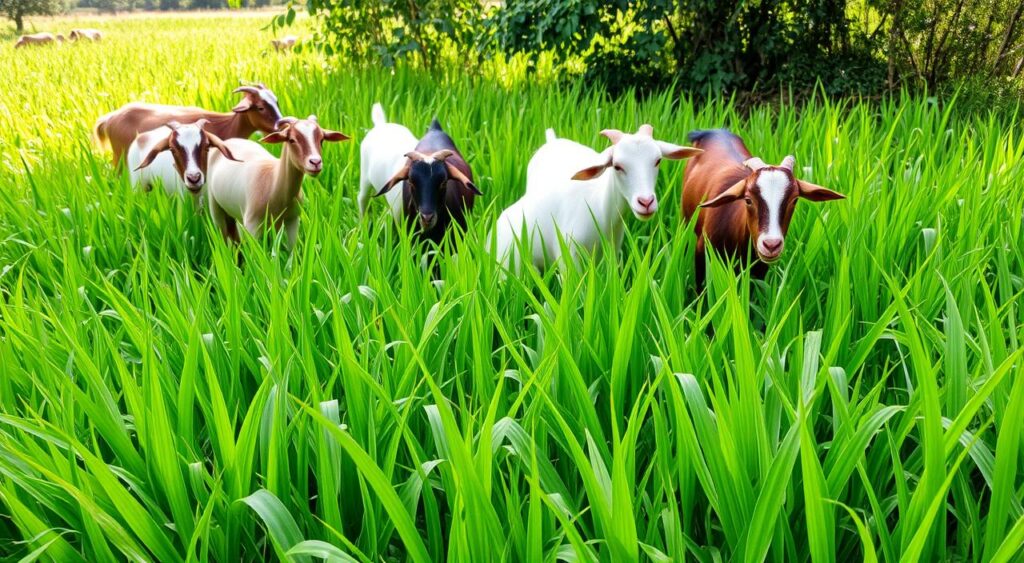
The benefits of digestibility when feeding Mombasa grass to goats are also significant. When goats digest their food well, they take in nutrients better. This supports their health, growth, and productivity. Mombasa grass is easier for goats to digest when it’s young. This leads to better growth for the goats.
- High palatability ensures that goats are more inclined to consume sufficient quantities of Mombasa grass, thus meeting their nutritional needs.
- Optimal digestibility translates into more efficient nutrient absorption, promoting healthier and more productive goats.
Mombasa grass offers major benefits for goats’ health and farm sustainability. It leads to healthier, more productive goats. Plus, it lets farmers use great natural foods for their animals.
Optimizing Goat Health with Mombasa Grass: A Complete Guide
As goat farmers, we always search for ways to better our herd’s health and performance. Introducing Mombasa grass to their diet does just that. It’s packed with nutrients that strengthen their immune system and help prevent diseases.

Mombasa grass is not only full of nutrients but also suits sustainable goat farming well. It grows in different soils and climates, making it perfect for many farms. By understanding its impact on goat health, we can make smarter dietary choices.
Boosting Immune Function in Goats Through Proper Nutrition
Feeding your goats Mombasa grass can greatly improve their immune health. This type of grass is loaded with important nutrients. These are key for a strong immune system. Healthier goats get sick less often, which can mean lower vet bills.
Role of Mombasa Grass in Reducing Common Goat Diseases
Mombasa grass plays a big part in keeping goats disease-free. Its nutrient-rich profile means goats are less likely to catch common diseases. This grass keeps their digestion running smoothly and helps with nutrient uptake, essential for fighting off illnesses and staying healthy.
Adding Mombasa grass to your goat’s diet can make a big difference in their health and how well they perform. This is an investment in your animals that brings health benefits and economic ones. By learning about Mombasa grass’s advantages, you can improve your herd’s health and productivity the smart way.
Mombasa Grass for Goats Benefits
Mombasa grass is great for goats because of its mombasa grass advantages for goats. It provides a rich diet and improves goats’ health and productivity. Learning about its nutritional benefits is key for better livestock care.
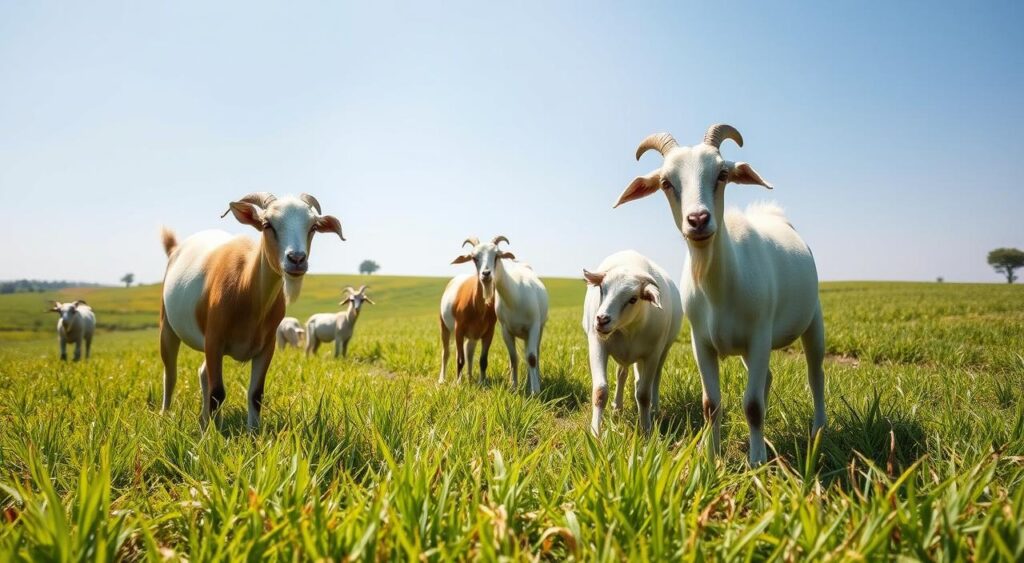
The mombasa grass nutritional benefits for goats include lots of protein. The soil quality changes how much protein you get. On average soils, the protein in Mombasa grass is between 10% to 15%. But with richer soils, it can reach 14% to 18%. This helps goats build muscle and stay healthy.
Mombasa grass produces more dry matter than many other forages, about 28% more than Guinea TD58. This means health benefits of Mombasa grass for goats include better weight gain. Studies show goats gain up to 770 kg/ha/yr with it, compared to 600 kg with other grasses.
| Crude Protein | Yield (Dry Matter/ha/yr) | Live Weight Gain (kg/ha/yr) | |
|---|---|---|---|
| Mombasa Grass | 10%-18% | 20-40 tons | 770 |
| Other Varieties | Up to 12% | Less by 28% | 590-600 |
Mombasa grass also lasts well in different conditions. It needs at least 8 hours of sunlight daily. It’s okay with a little drought and some shade too. When rotated in grazing, it helps soil health and reduces erosion.
Adding Mombasa grass to your goats’ diet does more than just feed them. It boosts their health, helps your farm, and ensures mombasa grass advantages for goats. This leads to a diet that helps them grow strong and lively.
Maximizing Milk Yield and Quality in Dairy Goats with Mombasa Grass
Adding Mombasa grass to dairy goats’ diets shows major benefits. It positively affects milk yield and quality. This grass merges nutrition with digestibility, enhancing dairy production.

Case Studies: Dairy Goats’ Performance on Mombasa Grass Diets
Studies have shown big benefits from including Mombasa grass in goats’ diets. For example, goats fed on Mombasa grass increased their milk production. This boost is essential for profitable farming. It supports other findings that highlight the grass’s importance in dairy goats’ performance.
How Mombasa Grass Influences Milk Components
Mombasa grass also improves milk quality, not just quantity. It raises milk fat and protein levels. This makes the milk better, meeting premium market standards.
The following table shows how Mombasa grass leads to better health and more milk in dairy goats:
| Dietary Treatment | Crude Protein | Organic Matter | Milk Yield Increase (%) |
|---|---|---|---|
| 100% Napier Grass | Low | Medium | 0% |
| 75% Napier Grass + 25% Sorghum Silage | Medium | High | 5% |
| 50% Napier Grass + 50% Sorghum Silage | Medium | High | 10% |
| 25% Napier Grass + 75% Sorghum Silage | High | Very High | 15% |
| 100% Mombasa Grass | Very High | Very High | 20% |
This data shows Mombasa grass’s role in boosting milk production and quality. It proves the point of using this grass in goats’ diets for better dairy results.
The Impact of Mombasa Grass on Goat Meat Production
Adding Mombasa grass to goat diets has greatly improved meat production. It’s important to understand how this grass affects meat quality and weight gain. This knowledge can change how you feed your livestock for better results.
Meat Quality Parameters Affected by Mombasa Grass Feeding
Studies show Mombasa grass has many benefits for livestock, especially goats. A mix of 50% concentrate feed and 25% Panicum Mombasa silage boosts digestibility and nutrient use. This blend improves nutrient quality in goat meat.
Live-Weight Gain and Feed Efficiency in Meat Goats
Feeding goats with Mombasa grass leads to higher weight gain and feed efficiency. When Mombasa grass is used in silage mixtures, it helps goats grow faster and healthier. This is because it increases food intake and the body uses nutrients better.
Using Mombasa grass in goat feed improves meat production and supports environmentally friendly farming. Let’s look at how these benefits are shown in research data:
| Diet Blend | Feed Intake (kg/day) | Digestibility (%) | Live-Weight Gain (g/day) |
|---|---|---|---|
| 50% CFM + 25% BS + 25% PMS | 3.2 | 70 | 260 |
| 100% BS | 2.9 | 65 | 200 |
| 100% PMS | 3.0 | 60 | 220 |
As shown in the table, Mombasa grass boosts intake, digestibility, and weight gain. These improvements show why Mombasa grass is key in goat nutrition and farm management.
Economical Advantages of Growing Mombasa Grass for Goat Farmers
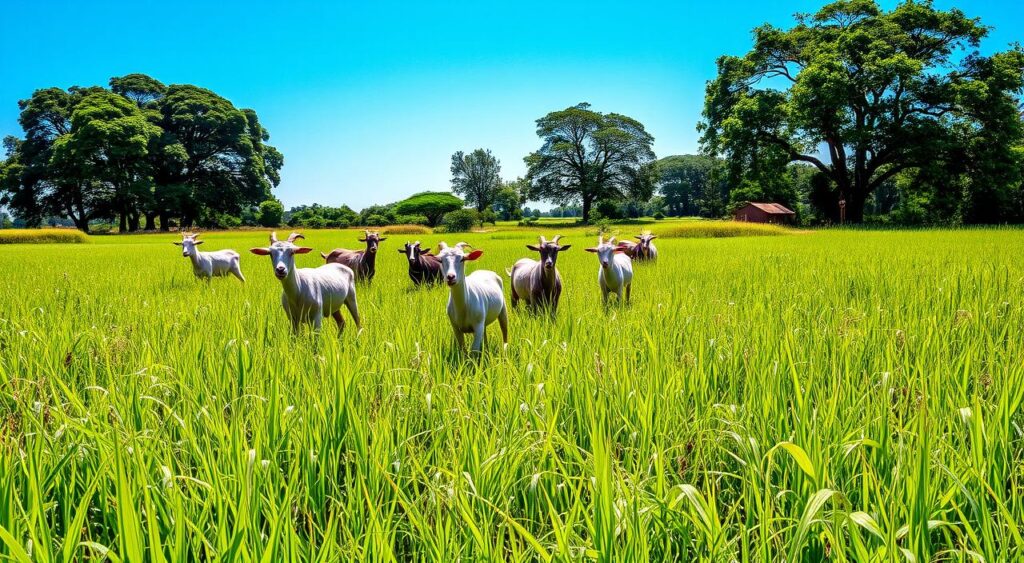
If you’re in goat farming, looking for better profit and productivity is a must. Mombasa grass (Panicum maximum cv. Mombasa) is an excellent choice. It is nutritious for goats and boosts the economy of your farm. In Kenya, drought from 2019 to 2022 showed the value of climate-smart agriculture, like Mombasa grass.
Cost-Benefit Analysis: Mombasa Grass vs. Traditional Feeds
Comparing costs of Mombasa grass and traditional feeds shows Mombasa’s economic benefit. KES 11 million was used to fix the Njoro Kubwa Canal, backing agricultural projects. Using Mombasa grass lowers feed costs. The Aberdare Welfare group’s experience, with increased milk production, highlights Mombasa grass’s economic value for goats. Better forage adoption, like Mombasa grass, also improves household incomes, as seen in the CIAT database. This shows the investment’s worth, especially with Mombasa grass’s durability.
Adapting Mombasa Grass to Different Farming Systems
Using Mombasa grass in various farming systems helps solve common problems like drought resistance and feed costs. Nyeri County’s push towards climate-smart practices, including Mombasa grass, demonstrates its flexibility. Research indicates Mombasa grass thrives with organic fertilizers and benefits from being planted with legumes, boosting yield and soil health. Further, proper cutting intervals and maintenance enhance its growth, protein content, and quality. Thus, with smart management, goat farmers can increase their returns from Mombasa grass.

